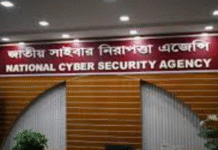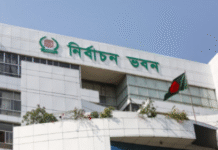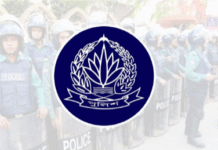City traffic in disorder
Poor traffic management amid metro rail construction causes sufferings to commuters

The metro rail construction work on 8km of the capital’s key thoroughfares has made the chaotic traffic even worse, largely because steps have not been taken for better use of the narrowed down streets, experts and officials said.
The elevated rail lines — from Agargaon to Motijheel via Farmgate, Shahbagh, Dhaka University and Press Club — is the second half of the 20km metro rail line-6.
Experts said the Dhaka Mass Transport Company Ltd (DMTCL) authorities had not done enough to alleviate public sufferings caused by the significant narrowing down of streets during construction of the first half — 12km from Uttara to Agargaon.
In the second half, the DMTCL is also building seven elevated stations and viaducts along the stretch.
Over 11 metres of the 22-metre-wide Kazi Nazrul Islam Avenue have now been occupied from the middle with concrete barriers placed way past the fast lane.
However, the remaining street width has not been widened and footpaths have not been cleared of obstacles, according to transport experts and traffic enforcement high officials.
As a result, traffic flow is seriously bottlenecked at Farmgate, Sonargaon, Shahbagh, Jatiya Press Club, and Paltan intersections.
The thoroughfares take thousands to and from work every day.
“The situation for pedestrians at Shahbagh intersection is awful and perilous, with the footbridge dismantled, battered pavements and the main road blocked with barrier. Only a narrow lane for motor vehicles is left,” Shahana Akhtar, an attendant to a patient at BSMMU, said recently.
Shariful Hasan, who commutes from Mirpur, said streets in Mirpur, from Pallabi to Agargaon, has been in deplorable condition over the last couple of years as the construction work is going on there.
Whatever road space is left for traffic is in tatters, pothole riddled, muddy or covered in thick layer of dust that get kicked up, he said.
Commuters have to deal with dust pollution and standstill traffic every day. On top of this, drainage system often stops working, submerging the streets and leaving them mucky afterwards, he said.
“The situation is such that it takes me two and half hours at midnight, when city streets are supposed to be almost empty, to get to Mirpur-10 roundabout from Farmgate on motorbike,” said Hasan.
For Dhaka Traffic Division, just keeping the traffic moving became its biggest challenge. The city traffic authority is disappointed as most of its recommendations for easing people’s movement went unheeded by the DMTCL authorities.
Mosleh Uddin Ahmed, joint commissioner for North Dhaka Traffic Division, said during a meeting of the metro rail project’s 20-member traffic management committee a couple of months ago, they again asked for road widening by reducing the width of the pavements and removing electric poles.
“They [DMTCL] are not doing it, so we said they have to first do it and then they would take up the road space [for construction], but they have taken the road width without widening the remaining active lanes,” he said.
Apart from this, diversions need to be made and parallel, adjoining, and feeder roads have to be repaired. When traffic is diverted, those roads have to be improved for dealing with the additional pressure. “They are not doing it in an organised way either,” he said.
“Either they [DMTCL] don’t understand traffic management or are not able to execute it accordingly,” said Mosleh Uddin.
“We told them that they have to prepare the roads where they intend to divert traffic from the main corridor. It also requires a lot of additional manpower. But they are not doing the job accordingly and only they know why,” he said.
They seem to think that they would just take up the road width for the construction work and police would deal with the traffic mess, he said.
“How can police do it unless they provide the police with engineering solutions? Coordination with police is vital. They have to do the traffic management like the way we want or people will suffer.”
If it is not done in time or as desired, the people will suffer, he added.
Mosleh Uddin’s counterpart in DMP South, Mofiz Uddin Ahmed, said traffic police made a set of recommendations to the project authority and also shared those with all relevant authorities, including the “highest level” of the government, last October.
He said they had recommended keeping the roads and pavements useable and clean, ensuring good environment, and making sure people and traffic are able to move smoothly in key spots before the DMTCL embarked on the construction work.
Asked if the metro rail authorities had taken measures accordingly, he said, “In some cases only.”
Mofiz said they wanted the metro rail authorities to issue regular public notices on how to use the adjoining roads, on diversions, and management plans.
Prof Shamsul Hoque, a transport expert and independent member of the metro rail’s traffic management committee, said he had no idea about the traffic management plan taken up by the authorities as he had not been invited to committee meetings in the last three years.
All over the world, metro rail schemes are implemented with relevant professionals in a responsible way and giving the highest priority to people’s ease of movement, safety, and environment conservation, said Prof Hoque.
“The project authorities were supposed to give priority to mass transportation modes, like double-deckers and other buses and restricting small vehicles like cars, three- or two-wheelers along the project corridor. But the situation is opposite here,” said Prof Hoque.
Millions of pedestrians are the worst victims of this traffic mismanagement and they are most vulnerable to accidents as well, Prof Hoque added.
He feared that roads near proposed metro stations would be significantly chocked and horrific traffic jams would be triggered. The situation would be extremely difficult at Sonargaon intersection because the work has to go on keeping the Saarc fountain intact.
Moazzem Hossain, a transport expert and professor of civil engineering at Bangladesh University of Engineering and Technology, said, “Public suffering would have been minimal had components of the structure been pre-fabricated off site and assembled on site later.”
They are trying to do everything at the site, apparently to save cost, he claimed.
This paper repeatedly sought comments from the metro rail implementing company, DMTCL.
Metro rail line-6 Project Director Md Aftabuddin Talukder, who is also the convener of the 20-member traffic management committee, and Managing Director MAN Siddique were reached out to via text messages.
None responded.
The Daily Star correspondent then contacted Siddique’s office several times but was told the MD was busy. This correspondent was directed to the public relations officer of the company Khan Md Mizanul Islam who advised going to the MD’s office in person.
This correspondent along with a photojournalist then went to the DMTCL office but was not allowed to meet the MD or get an appointment.
On May 6 and May 8, The Daily Star contacted the MD’s office again but was told on both occasions that he was busy and the message could not be conveyed.
Asked about traffic management measures taken, Khandakar Rakibur Rahman, executive director of Dhaka Transport Coordination Authority, said, “Why should we tell you that?”
“Police and DMTCL manage the traffic the way they can and they are supposed to tell you about it,” said Rakibur, when pointed out that he leads the transport coordination authority in the capital.
The 20-member traffic management committee was formed in November 2015 comprising representatives from Dhaka Transport Coordination Authority, traffic police, the project consultant, Bangladesh Road Transport Authority, other authorities, and an independent expert.
The construction work is scheduled to complete by June 2024 but the government wants it done by the end of 2022.









